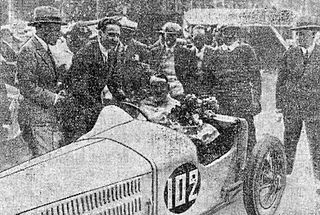
Maurice Jean-Paul Boyau was a French rugby union player and a leading French ace of the First World War with 35 victories, and one of the most successful balloon busters. Balloon busting was the dangerous act of bringing down enemy observation balloons; these balloons were densely protected by anti-aircraft artillery and patrol flights.

General Joseph Vuillemin was a French professional soldier whose early interest in aviation led him into increasingly responsible leadership positions in the Aeronautique Militaire during World War I. Ending the war with extensive decorations, including an unusual double award of the Legion d'honneur, as well as seven aerial victories, he became a dynamic leader of an aerial expedition to Africa in 1933. His climb through the ranks continued until World War II, when he became Chief of Staff of the French Air Force during the first year of World War II.

Sous Lieutenant René Pierre Marie Dorme, Légion d'honneur, Médaille militaire, Croix de Guerre was a French World War I fighter ace credited with at least confirmed 23 victories.

Sous Lieutenant Gabriel Fernand Charles Guérin, Legion d'honneur, Medaille militaire, Croix de Guerre, was a World War I fighter pilot credited with 23 confirmed aerial victories.

Colonel Marcel Émile Haegelen, Légion d'honneur, Médaille militaire, Croix de Guerre, was a World War I French flying ace credited with 22 victories.
Captain Gustave Naudin was a French World War I flying ace credited with six aerial victories. He returned to his nation's defense during World War II, serving as an infantry officer.
Sous Lieutenant Fernand Henri Chavannes (1897-1985) was a French World War I flying ace credited with seven aerial victories.
Sous lieutenantDel Antoine Gaston Vial served in an artillery regiment from 1912 to 1913, when he transferred to aviation. He became a flying ace during World War I by scoring eight aerial victories. Another notable achievement of his was his frequent participation in long range bombardment missions.

Lieutenant Jean Chaput was a French World War I flying ace credited with 16 aerial victories.

Adjutant André Julien Chainat was a French World War I flying ace credited with eleven aerial victories.
Sous Lieutenant Jean Pie Hyacinthe Paul Jerome Casale, was a French World War I flying ace credited with thirteen aerial victories. He was one of the few aces that survived the entire course of fighter aviation in the war.

Adjutant Maxime Albert Lenoir was a pioneering World War I flying ace credited with eleven confirmed aerial victories, as well as eight unconfirmed.
Capitaine Gustave Victorin Daladier was a French World War I flying ace credited with twelve aerial victories. He would continue in his nation's military service after World War I.
Sous lieutenantOmer Paul DemeuldreLégion d'honneur, Médaille militaire, Croix de Guerre, Mentioned in Dispatches was a World War I French flying ace credited with 13 aerial victories.
Lieutenant Colonel André René Celestin Herbelin was a French flying ace during World War I. He was credited with eleven confirmed aerial victories. He returned to his country's defense again during World War II, becoming part of the French Resistance against the Nazis.
Commandant Jacques Toussaint François Ortoli was a French Corsican patriot who served France in two World Wars. In World War I, he was a flying ace credited with eleven confirmed aerial victories. He returned to his nation's defense during World War II.
Général Auguste Joseph Marie Lahoulle was a French military officer who began his career as a World War I flying ace. He was a double ace during the war, credited with ten confirmed aerial victories.
Lieutenant Colonel Jean André Pezon began his military career during World War I and became a flying ace credited with ten confirmed aerial victories. He served his nation throughout World War II.

Colonel Marcel Marc Dhôme began his military career during World War I, when he became a flying ace credited with nine confirmed aerial victories. He also served France in World War II, and during the Korean War.

Capitaine Gustav Douchy (1893-1943) was a French military officer who served in both World Wars. He was a flying ace in World War I, credited with nine confirmed aerial victories.










